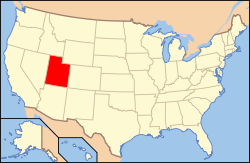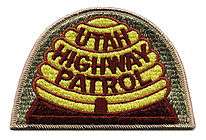Utah Highway Patrol
| Utah Highway Patrol | |
|---|---|
| Abbreviation | UHP |
|
Patch of the Utah Highway Patrol | |
| Agency overview | |
| Formed | 1923 |
| Preceding agency | State Road Patrol Police |
| Employees | 1,018 (as of 2004)[1] |
| Legal personality | Governmental: Government agency |
| Jurisdictional structure | |
| Operations jurisdiction* | State of Utah, United States |
 | |
| Map of Utah Highway Patrol's jurisdiction. | |
| Size | 84,889 square miles (219,860 km2) |
| Population | 2,645,330 (2007 est.)[2] |
| Legal jurisdiction | Utah |
| Governing body | [[Superintendent[3]]] |
| General nature | |
| Operational structure | |
| Headquarters | Salt Lake City |
| Troopers | 475 (as of 2008)[4] |
| Civilians | 480 (as of 2004)[1] |
| Agency executive | Daniel Fuhr, Colonel |
| Parent agency | Utah Department of Public Safety |
| Facilities | |
| Stations | 29 |
| Website | |
|
highwaypatrol | |
| Footnotes | |
| * Divisional agency: Division of the country, over which the agency has usual operational jurisdiction. | |
The Utah Highway Patrol (UHP) is the functional equivalent of the state police for the State of Utah in the United States. Its sworn members, known as Troopers are certified law enforcement officers and have statewide jurisdiction.[5] It was created to "patrol or police the highways within this state Utah and to enforce the state statutes as required."[6]
Issued vehicles and weapons

The UHP has a mixed fleet of vehicles: Ford CVPI, Dodge Charger, Chevy Z71 Suburbans, and multiple Dodge and Ford pickups. The UHP also issues its troopers take home cars, which can be used within 50 miles (80 km) of their assigned county. The large Ford Crown Victorias previously used statewide have been superseded by special-edition Ford Mustangs.
The UHP issues its state troopers the Glock 17 Gen 4 9mm caliber or Glock 18 9mm machine pistol (The Glock 18 is issued to Section 18: Governor's Security Detail Troopers only). (Troopers may also carry a personal weapon, provided it is chambered in 9mm, .40 S&W, or .45 auto.). Troopers are also issued the Remington 870 12 gauge shotgun and each patrol vehicle carries a Colt AR-15/M4 carbine assault rifle. Prior to issuing AR-15's, The Patrol began participating in a program with the US Government and purchased surplus M-14 rifles. Troopers also carry tasers, expandable batons, and pepper spray. The UHP continues to issue and utilize the M-14 rifle, especially in rural areas of the state. The carbines are primarily issued to Troopers in urban and densely populated areas.
Fallen officers

Since the establishment of the Utah Highway Patrol, 16 officers have died while on duty.[7][8]
- William John Antoniewicz (1974)
- Aaron Beesley (2012)
- Joseph "Joey" Samuel Brumett III (1992)
- Daniel W. Harris (1982)
- Robert B. Hutchings (1976)
- Randy K. Ingram (1994)
- Armond A. "Monty" Luke (1959)
- Dennis "Dee" Lavelle Lund (1993)
- Ray Lynn Pierson (1978)
- Dee Rees (1960)
- Tom Rettberg (2000)
- Doyle R. Thorne (1994)
- George "Ed" Van Wagonen (1931)
- Eric Dale Ellsworth (2016)
- Charles D. "Chuck" Warren (1994)[Note 1]
- John R. Winn (1971)
Controversies
DWI Task Force
The UHP has been involved in several incidents which have gained local news attention.
Nate Carlisle, in The Salt Lake Tribune, reported that: In a memo in 2010, "Sgt. Rob Nixon said he reviewed 20 of Steed's arrests for driving under the influence of drugs and found in seven of those cases, toxicology tests showed the driver had only a low amount of drugs, referred to as metabolite. Four other drivers had no drugs in their system, according to Nixon's memo. Yet in every case, Steed wrote reports claiming the drivers showed signs of impairment, such as dilated pupils and leg and body tremors. Nixon referred to "a pattern" of conflicting information between Steed's arrest reports and the laboratory results and said: "This is something that needs to be addressed before defense attorneys catch on and her credibility along with the DUI squad's credibility is compromised." UHP last year said they addressed some of Nixon's concerns with Steed, but apparently no formal review was done until Winward undertook it. Fuhr said the Winward review demonstrates Steed always had cause to suspect the person she arrested was impaired or otherwise not supposed to drive. Even in the few cases where the toxicology tests did not reveal drugs, an admission of recent drug use or other suspicious signs could be used as evidence to convict someone of a charge of driving with a controlled substance in their system. Also, the Nixon memo has been misinterpreted, Fuhr said. Nixon was not accusing Steed of arresting innocent people, but rather saying she sometimes arrested people on suspicion of the wrong charge. Utah has separate offenses for drivers under the influence of drugs and those who only have drugs in their system. Nixon's memo also described helping Steed arrest a man who showed little sign of impairment, but whom Steed reported to be exhibiting dilated pupils and tremors. Fuhr said Nixon got that case wrong, and pointed to documents saying the driver admitted to using meth two days earlier, and was "pretty hooked." Documents indicated he tested positive for meth. Steed's report said she also found a baggy with white powder and a pipe with meth residue. The court case was not so cut-and-dried. After that driver was charged in Salt Lake County Justice Court with misdemeanor DUI, drug possession and two traffic violations, charges were dismissed in 2011. A court docket says the prosecutor dismissed the charges for "evidentiary reasons." Attorneys in the case did not respond to messages seeking a further explanation. UHP did not make Nixon available for an interview with The Tribune. Hamilton said he has been unable to determine how many of Steed's arrests resulted in successful prosecutions. UHP has said it does not have those numbers. UHP is having to defend Steed in the civil rights lawsuit. Fuhr, who may give a deposition in that case, expressed frustration at news reports saying Steed was fired for making false arrests. She was fired for problems with her testimony, and UHP, Fuhr said, has not found evidence Steed manufactured evidence. "When these stories go out," Fuhr said of the false arrest allegations, "it hurts every single trooper."" Lisa Steed was named the Utah Highway Patrol trooper of the year in 2007 for her many many DUI arrests. She was the first woman to receive this award. In court March 27, 2012, Steed admitted she intentionally violated the agency's policies twice during a 2010 traffic stop.
Memorial crosses
On November 20, 2007, a judge ruled that the 14 white crosses erected by the Utah Highway Patrol Association could remain in place. An atheist group had filed suit, claiming the memorials were a violation of the separation of church and state.[10] However, on 18 August 2010, the 10th Circuit Court of Appeals ruled that the white roadside crosses used to memorialize the deaths of 14 Utah Highway Patrol troopers are unconstitutional, government endorsements of religion on public lands. "We hold that these memorials have the impermissible effect of conveying to the reasonable observer the message that the state prefers or otherwise endorses a certain religion."[11] The Utah Highway Patrol Association had claimed that "roadside crosses, in particular, are secular symbols," and have erected signs saying "not a state endorsement of any religion."[12]
Safe driving campaigns
1-877-JAIL-FON
1-877-JAIL-FON was a service phone number created by the Utah Highway Patrol that allowed people to practice the "one phone call" from jail if arrested for a Driving Under the Influence (including any substance that impairs driving ability).[13][14]
See also
Notes
References
- 1 2 "USDOJ Bureau of Justice Statistics Census of Law Enforcement Agencies" (PDF). ojp.usdoj.gov. United States Department of Justice. Jun 2007. p. 6. Retrieved 19 Apr 2016.
- ↑ "Archived copy". Archived from the original on July 12, 2011. Retrieved December 3, 2013. 2008 Population Estimates
- ↑ Utah State Code, Section 53.8.103(2) Accessed 19 September 2012
- ↑ "USDOJ Bureau of Justice Statistics Census of Law Enforcement Agencies" (PDF). ojp.usdoj.gov. United States Department of Justice. Jul 2011. p. 7. Retrieved 19 Apr 2016.
- ↑ "Title 53 Chapter 8 Part 1 Section 106". le.utah.gov. Utah State Legislature. 1993. Retrieved 19 Apr 2016.
- ↑ "Title 53 Chapter 8 Part 1 Section 105". le.utah.gov. Utah State Legislature. 2005. Retrieved 19 Apr 2016.
- 1 2 "Fallen Troopers". honoringheroesfoundation.org. Utah Highway Patrol Honoring Heroes Foundation. Retrieved 19 Apr 2016.
- ↑ "Officer Down Memorial Page: Utah Highway Patrol". odmp.org. Officer Down Memorial Page. Retrieved 30 Nov 2016.
- ↑ "Trooper Charles D. Warren". odmp.org. Officer Down Memorial Page. Retrieved 19 Apr 2016.
- ↑ "UTAH'S CROSS CONTROVERSY". Newsweek. 16 Nov 2007. Retrieved 19 Apr 2016.
- ↑ Falk, Aaron (18 Aug 2010). "Judges rule against Utah highway crosses for fallen troopers: Utah's attorney general strongly disagrees with appeals court". Deseret News. Salt Lake City: Deseret Digital Media. Retrieved 19 Apr 2016.
- ↑ utahtrooper.com website Archived November 20, 2011, at the Wayback Machine.
- ↑ Reavy, Pat (28 Aug 2009). "Campaign to fight DUI offers 'jail call'". Deseret News. Salt Lake City: Deseret Digital Media. Retrieved 19 Apr 2016.
- ↑ "New approach to drunk driving prevention". ksl.com. Salt Lake City: Deseret Digital Media. 27 Aug 2009. Retrieved 19 Apr 2016.
External links
| Wikimedia Commons has media related to Utah Highway Patrol. |
- Official website
- Utah Highway Patrol on Facebook
- Utah Highway Patrol on Twitter

- Utah Highway Patrol's channel on YouTube
- Utah Highway Patrol Act (within the Utah State Code)
- Utah Highway Patrol Association (official website)
- Utah Highway Patrol Honoring Heroes Foundadation
- Officer Down Memorial Page: Utah Highway Patrol
